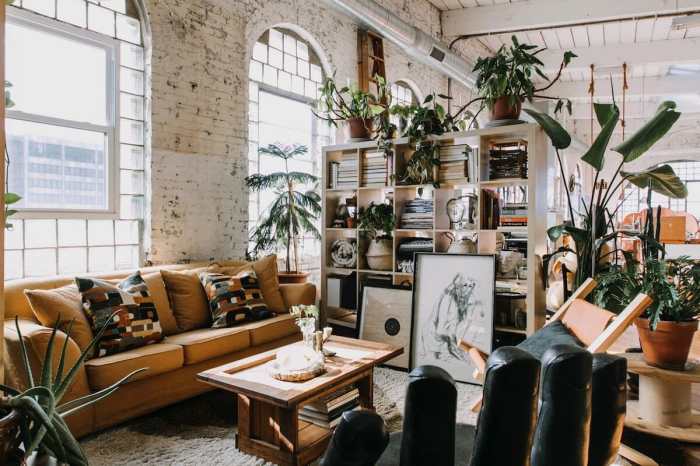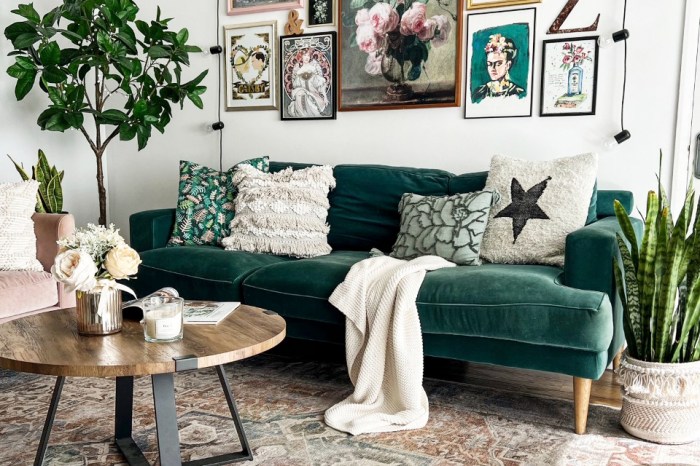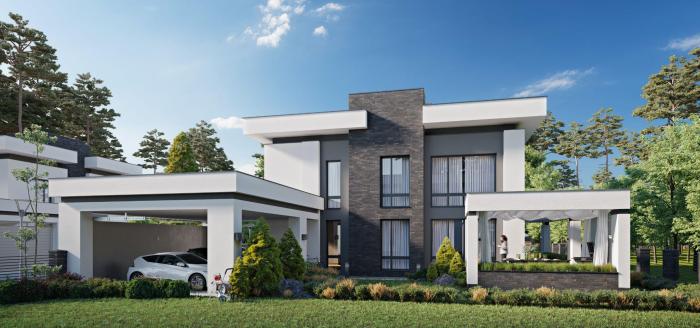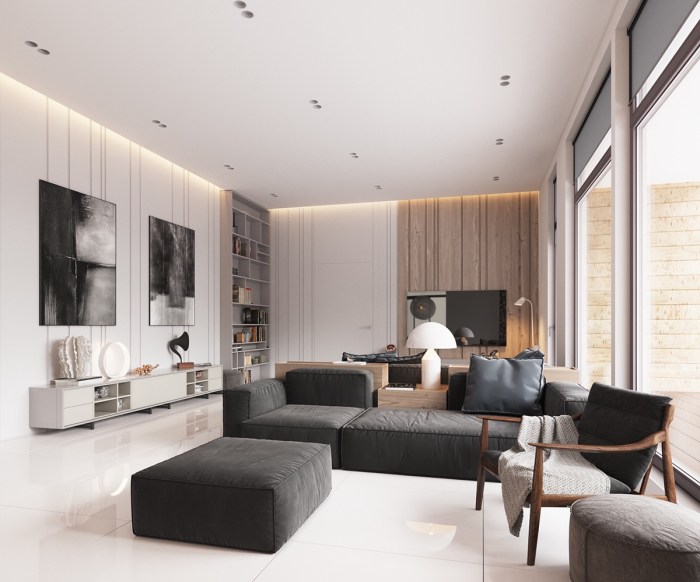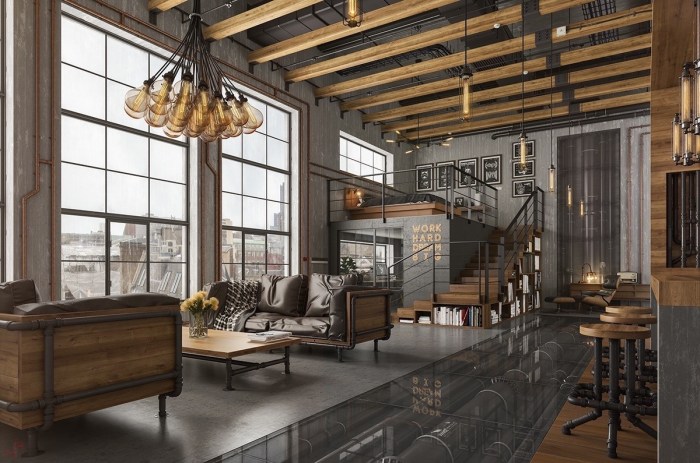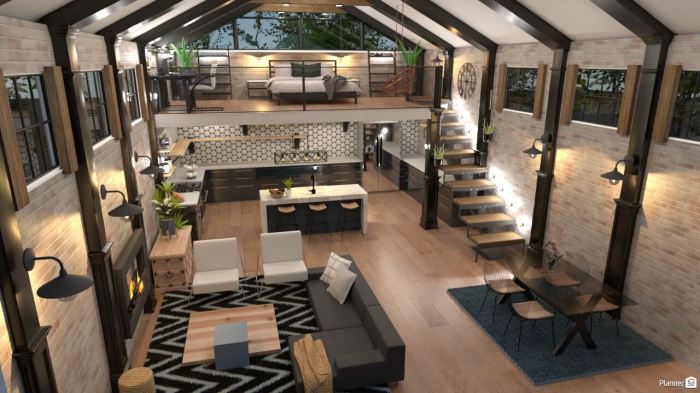Minimalist bedroom design in 2024 transcends mere aesthetics; it’s a mindful approach to creating a sanctuary of calm and functionality. This year’s trends embrace clean lines, natural materials, and a considered use of color to foster relaxation and well-being. We’ll explore the science behind color psychology in bedroom design, examining how specific palettes influence mood and sleep quality. Further, we will delve into the practical aspects of space optimization, furniture selection, and lighting strategies to maximize both comfort and visual appeal in your minimalist haven.
From understanding the psychological impact of color choices to strategically incorporating natural elements and optimizing storage solutions, we will dissect the key components of crafting a truly restorative and stylish minimalist bedroom. We’ll examine different furniture styles, lighting techniques, and the role of textiles in creating a space that reflects both your personal style and the principles of mindful living.
This exploration will move beyond mere decoration, delving into the science of creating a space that promotes rest, rejuvenation, and a sense of peaceful serenity.
Trending Minimalist Bedroom Styles 2024
Minimalist bedroom design in 2024 reflects a growing desire for calm, functional spaces that prioritize well-being. This trend moves beyond mere simplicity, incorporating sophisticated palettes, carefully chosen textures, and an understanding of how light and materiality impact mood and perception. The focus is on creating havens of tranquility through considered design choices.
Three Distinct Minimalist Bedroom Styles for 2024
Three distinct minimalist bedroom styles are emerging as prominent trends in 2024, each offering a unique aesthetic and atmosphere. These styles demonstrate the versatility of minimalist principles, showcasing how a core philosophy can be adapted to diverse preferences and living situations.
- The Scandinavian Sanctuary: This style emphasizes natural light and a palette of whites, creams, and light greys, accented with natural wood tones and pops of muted blues or greens. Furniture is simple and functional, often featuring light-colored wood or white-painted finishes. Think a light oak bed frame, a simple white dresser, and a woven jute rug. Textiles are predominantly linen and cotton, chosen for their breathability and natural texture.
The overall feeling is one of airy spaciousness and serene calm.
- The Japanese Zen Garden: Inspired by Japanese aesthetics, this style prioritizes simplicity and functionality above all else. A neutral color palette of greys, blacks, and whites dominates, with subtle textures introduced through natural materials like bamboo and paper. Low-profile furniture, such as a platform bed and a minimalist nightstand, contributes to a sense of spaciousness. Natural light is maximized, and artificial lighting is minimal and warm, using paper lanterns or simple bedside lamps.
Textiles are predominantly natural fibers like cotton and silk, creating a feeling of understated elegance and tranquility.
- The Urban Minimalist Retreat: This style blends minimalist principles with urban sophistication. A darker palette is employed, featuring charcoal greys, deep blues, and black accents, creating a moody yet refined atmosphere. Materials like concrete, metal, and dark wood are incorporated into the design, alongside sleek, modern furniture pieces. Artificial lighting plays a more significant role, using strategically placed track lighting and statement pendant lights to highlight architectural details and create a sense of drama.
Luxurious textiles like silk and velvet add a touch of opulence, balancing the industrial elements and enhancing the overall sophistication.
The Role of Natural and Artificial Lighting in Minimalist Bedrooms
The interplay of natural and artificial lighting is crucial in shaping the atmosphere of a minimalist bedroom. In the Scandinavian Sanctuary style, natural light is maximized through large windows and light-colored walls, creating a bright and airy space. Artificial lighting is supplementary, used to create a warm ambiance in the evenings. The Japanese Zen Garden style similarly prioritizes natural light, but artificial lighting is more subdued, using soft, warm tones to enhance the sense of tranquility.
In contrast, the Urban Minimalist Retreat style employs a more balanced approach, using both natural and artificial light to create a dynamic and sophisticated environment. Artificial lighting, in this case, becomes a design element itself, contributing to the overall aesthetic.
The Impact of Textiles on Minimalist Bedroom Aesthetics
The choice of textiles significantly influences the overall feel and aesthetic of a minimalist bedroom. Linen, with its natural wrinkles and breathable texture, creates a relaxed and informal atmosphere, perfectly suited for the Scandinavian Sanctuary and Japanese Zen Garden styles. Cotton offers a similar natural feel but can be more structured, depending on the weave. Silk, with its luxurious sheen and smooth texture, adds a touch of elegance and sophistication to the Urban Minimalist Retreat, enhancing the sense of calm and opulence.
The selection of textiles should be carefully considered to complement the overall design scheme and contribute to the desired atmosphere.
Color Palettes and their Psychological Impact
The impact of color on human psychology is a well-documented phenomenon, influencing mood, behavior, and even physiological responses. In the context of minimalist bedroom design, carefully chosen color palettes are crucial for creating a serene and restorative environment conducive to sleep and relaxation. The strategic use of color can transform a space, enhancing its functionality and aesthetic appeal while directly impacting the occupant’s well-being.
Color Palette Influence on Minimalist Bedroom Atmosphere
The selection of a color palette significantly influences the mood and atmosphere within a minimalist bedroom. Cool colors, for example, tend to evoke feelings of calmness and tranquility, while warmer tones can create a sense of warmth and comfort. However, the intensity and saturation of these colors also play a critical role. A muted, desaturated blue will promote relaxation far more effectively than a bright, vibrant blue, which could be stimulating and even overwhelming in a bedroom setting.
Similarly, a soft, creamy beige can offer a sense of warmth without being overly intense, unlike a bold, saturated yellow. The interplay of color temperature, saturation, and value (lightness or darkness) allows for a wide range of atmospheric effects within a minimalist design framework.
Calming Color Palettes for Relaxation and Sleep
A minimalist bedroom should prioritize relaxation and sleep. Achieving this requires careful consideration of the color palette. Three particularly effective calming palettes are detailed below. Their effectiveness stems from scientific understanding of color psychology and the physiological responses they elicit.
| Color Palette | Description | Psychological Effect | Suitable Minimalist Style |
|---|---|---|---|
| Soft Blue and White | Pale blues, varying from sky blue to a muted periwinkle, paired with crisp white accents. | Evokes feelings of peace, tranquility, and spaciousness. Blue has been shown to lower heart rate and blood pressure, promoting relaxation. White enhances the sense of cleanliness and openness. | Scandinavian Minimalism, Coastal Minimalism |
| Neutral Greys and Warm Whites | A range of greys, from light dove grey to a slightly darker charcoal, combined with off-white or warm cream tones. | Creates a sense of calm sophistication. Grey is known for its neutrality, avoiding stimulation while offering visual interest. Warm whites provide a subtle touch of warmth without overwhelming the calming effect of the greys. | Japandi Minimalism, Modern Minimalism |
| Earthy Greens and Natural Browns | Muted greens, reminiscent of nature (sage, olive), paired with natural brown wood tones and accents. | Connects occupants to nature, promoting a sense of grounding and serenity. Green is associated with balance and harmony, while brown provides a sense of stability and security. | Organic Minimalism, Wabi-Sabi Minimalism |
| Muted Teal and Ivory | A soft, desaturated teal, reminiscent of calm ocean waters, combined with a creamy ivory. | Combines the calming effects of blue with the warmth and sophistication of ivory. The combination creates a tranquil and elegant atmosphere. | Coastal Minimalism, Modern Minimalism |
| Rose Quartz and Greige | A pale, muted rose pink, almost lavender-like, paired with a blend of grey and beige (greige). | Offers a gentle, comforting atmosphere. The rose quartz adds a touch of softness and warmth, while the greige maintains a sense of calm neutrality. | Modern Minimalism, Bohemian Minimalism |
Furniture Selection and Placement
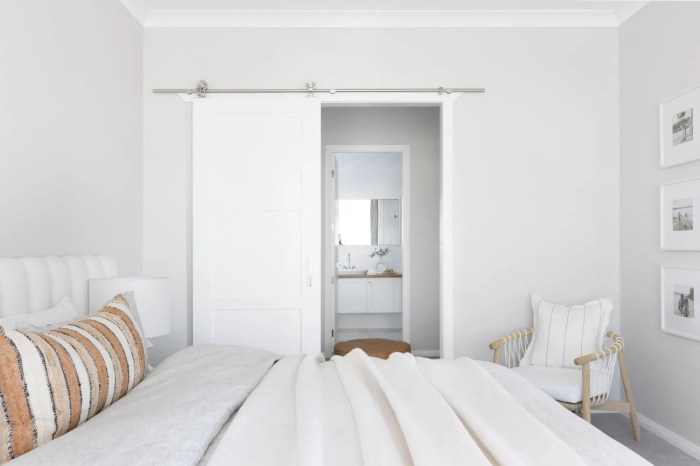
Creating a minimalist bedroom involves a careful selection and strategic placement of furniture to maximize space and enhance the feeling of calm and serenity. The goal is to curate a space that is both functional and aesthetically pleasing, reflecting the principles of minimalism: simplicity, intentionality, and functionality. This necessitates a thoughtful approach to furniture choice and arrangement.
A well-designed minimalist bedroom layout prioritizes functionality and visual balance. Overcrowding is avoided, and each piece serves a clear purpose. The arrangement considers the flow of movement within the room, ensuring ease of access and a sense of spaciousness. Natural light and ventilation are also key considerations, influencing the placement of furniture to optimize their benefits.
Minimalist Bedroom Layout: A Visual Description
Imagine a rectangular bedroom. Centrally positioned is a low platform bed, its clean lines and neutral color palette contributing to the room’s overall serenity. The bed’s headboard is flush against the longest wall, allowing ample space on either side for nightstands. These nightstands, simple and unadorned, are positioned equidistantly from the bed, each holding a small table lamp and a book.
Across from the bed, a minimalist wardrobe with sliding doors is seamlessly integrated into the wall, maintaining the clean lines of the design. The wardrobe’s color matches the bed frame, creating visual harmony. A small, comfortable armchair sits in a corner, near a window, providing a space for reading or relaxation. This arrangement maximizes floor space, promotes a sense of calm, and ensures easy movement throughout the room.
The rationale is to maintain a sense of spaciousness while still offering all essential furniture pieces.
Comparison of Minimalist Bed Types
Platform beds, canopy beds, and daybeds each offer unique functional and aesthetic characteristics within a minimalist context. Platform beds, with their low profile and integrated frame, offer a clean, uncluttered aesthetic and maximize floor space. Canopy beds, while potentially adding a touch of elegance, can feel visually heavy if not carefully chosen; a minimalist canopy bed might feature a simple, lightweight frame and sheer curtains for a delicate touch.
Daybeds, offering both seating and sleeping functionality, are ideal for smaller spaces but might lack the visual sophistication of a platform bed unless carefully selected and styled with minimalist principles. The choice depends on personal preference and the specific spatial constraints of the bedroom. A platform bed, for example, offers a clean aesthetic and maximized floor space, while a daybed offers multi-functionality suitable for smaller rooms.
Benefits of Multi-Functional Furniture
Incorporating multi-functional furniture is crucial in minimalist design, maximizing space and minimizing clutter. A storage ottoman, for instance, provides both seating and concealed storage for blankets or extra bedding. A bed with built-in drawers offers additional storage space without sacrificing valuable floor area. A wall-mounted desk folds away when not in use, converting a workspace into a free-flowing sleeping area.
These pieces optimize space and maintain the uncluttered aesthetic of a minimalist bedroom, avoiding the visual overload that can arise from numerous individual pieces. Such furniture pieces significantly contribute to the efficient use of space, a core principle of minimalist design.
Incorporating Natural Elements
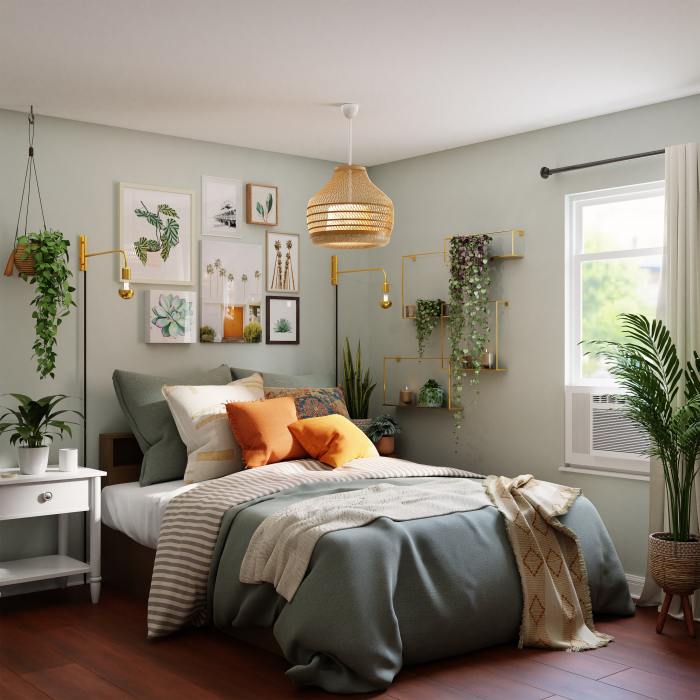
Minimalist design, while prioritizing simplicity, shouldn’t sacrifice warmth or connection to the natural world. The strategic incorporation of natural elements – wood, plants, and stone – significantly enhances a minimalist bedroom’s aesthetic appeal and contributes to a calmer, more restorative sleep environment. These elements offer both visual and tactile benefits, creating a space that feels grounded and serene.The presence of natural materials in the bedroom has been shown to reduce stress and improve overall well-being.
Studies have linked exposure to natural light and greenery to lower cortisol levels (the stress hormone) and improved mood. Furthermore, the biophilic design principle, which emphasizes the integration of nature into built environments, is increasingly recognized for its positive impact on mental and physical health.
Five Ways to Integrate Natural Elements in a Minimalist Bedroom
The following methods demonstrate how to seamlessly incorporate natural materials, creating a space that feels both modern and connected to nature. Careful selection and placement are key to maintaining the minimalist aesthetic while maximizing the calming effects of these elements.
- Wood accents: A simple wooden headboard, a bedside table crafted from reclaimed wood, or even a subtly textured wooden floor can introduce warmth and visual interest without overwhelming the minimalist aesthetic. The grain of the wood adds a natural texture that contrasts beautifully with the clean lines of minimalist furniture. Consider light-colored woods like birch or ash for a brighter feel, or darker woods like walnut for a more sophisticated atmosphere.
- Live plants: Strategically placed plants introduce life and vibrancy. Their calming green hues and the subtle movement of their leaves create a sense of tranquility. Consider air-purifying plants like snake plants or spider plants, known for their ability to improve indoor air quality. Placement should be thoughtful, avoiding overcrowding.
- Stone elements: A small stone accent piece, such as a polished river stone on a bedside table, or a stone-tiled wall section (if feasible) can add a touch of earthy texture and visual interest. The cool temperature of stone provides a pleasant contrast to warmer materials like wood. Choose a stone with a simple, unfussy appearance to maintain the minimalist aesthetic.
- Natural fiber textiles: Incorporate natural fiber textiles like linen or cotton for bedding and throws. These materials offer a soft, breathable texture that enhances the sense of comfort and relaxation. Their natural, slightly imperfect appearance adds a layer of warmth and character.
- Natural light maximization: While not a material, maximizing natural light is crucial. Open curtains and blinds during the day to allow sunlight to flood the room. Sunlight regulates our circadian rhythm, improving sleep quality and promoting a sense of well-being. This also enhances the perception of natural elements within the space.
Designing a Small Minimalist Indoor Garden
A small, carefully curated indoor garden can transform a minimalist bedroom into a peaceful sanctuary. The key is to select plants that thrive in low-light conditions and avoid overcrowding.Consider a small grouping of plants in a single, simple pot or planter. Snake plants, ZZ plants, and pothos are excellent choices for their low-maintenance nature and tolerance of low light.
Place the planter on a bedside table or a windowsill, ensuring it doesn’t obstruct the flow of the room. Avoid overly decorative pots; a simple, neutral-colored ceramic pot complements the minimalist style. The plants should visually complement the existing color palette, not compete with it. Regular watering and occasional misting are essential to keep the plants healthy and vibrant.
Impact of Natural Materials on Texture and Warmth
The incorporation of natural materials significantly alters the texture and warmth of a minimalist bedroom. The smooth, cool surface of stone contrasts beautifully with the warm, slightly rough texture of wood. The soft, tactile quality of natural fiber textiles adds another layer of sensory richness. This interplay of textures creates a more dynamic and engaging space than one relying solely on smooth, manufactured surfaces.
The natural variations in color and grain within wood and stone introduce subtle visual interest, adding depth and character to the room without compromising the minimalist aesthetic’s clean lines and simplicity. The overall effect is a space that feels both sophisticated and inviting, grounding and tranquil.
Lighting and Ambiance
Lighting plays a pivotal role in shaping the mood and functionality of a minimalist bedroom. The right lighting scheme can transform a space from sterile to serene, enhancing both the aesthetic appeal and the overall well-being of its occupant. Careful consideration of light sources, their placement, and control mechanisms is crucial for achieving the desired ambiance.
A minimalist bedroom benefits from a layered lighting approach, combining different types of light sources to create depth and flexibility. This strategy allows for adaptability to various activities and moods, from focused work to restful sleep. The interplay of ambient, task, accent, and decorative lighting contributes to a dynamic and comfortable environment.
Types of Lighting for a Minimalist Bedroom
Selecting appropriate lighting fixtures is key to a successful minimalist design. The following five types offer diverse functionality and aesthetic contributions:
- Ambient Lighting: Provides overall illumination, setting the general mood. Recessed ceiling lights or a simple pendant light are ideal choices, offering even, soft light distribution without visual clutter. The soft glow of a recessed fixture, for instance, creates a sense of calm and spaciousness.
- Task Lighting: Provides focused light for specific activities like reading or applying makeup. A flexible articulated desk lamp or a bedside reading lamp with a directional light source ensures sufficient illumination without overwhelming the space. The adjustable arm of a desk lamp allows for precise light direction, minimizing glare and maximizing functionality.
- Accent Lighting: Highlights architectural features or artwork, adding visual interest. Track lighting can be strategically positioned to emphasize a piece of art or a textured wall. The focused beam of accent lighting draws attention to specific details, enhancing the overall aesthetic.
- Decorative Lighting: Contributes to the overall aesthetic of the room, acting as both a light source and a design element. A simple, elegant floor lamp or a stylish wall sconce can add a touch of sophistication while providing soft illumination. The sculptural form of a modern floor lamp can serve as a focal point, adding character to the space.
- Natural Lighting: Maximizes the use of natural light through sheer curtains or blinds. This allows for daytime illumination while maintaining privacy and control over light intensity. The gentle diffusion of natural light through sheer curtains creates a naturally bright and airy atmosphere.
Layered Lighting Scheme for a Minimalist Bedroom
A layered lighting scheme involves combining different lighting types to create a multi-dimensional lighting experience. This approach allows for flexibility and adaptability to different moods and activities. For example, a minimalist bedroom might utilize recessed ceiling lights for ambient lighting, a bedside lamp for task lighting, and a strategically placed accent light to highlight a piece of art.
This layered approach avoids harsh shadows and creates a comfortable and inviting atmosphere.
Using Dimmers and Smart Lighting
Dimmers and smart lighting systems offer precise control over the intensity and color temperature of the light, significantly impacting the mood and atmosphere. Dimmers allow for gradual adjustments, transforming the space from bright and energetic to soft and calming. Smart lighting systems offer even greater control, enabling automated scheduling, color customization, and remote operation via smartphone or voice commands. This level of control enables the creation of personalized lighting scenes tailored to specific activities or moods, promoting relaxation and improved sleep quality.
For example, a warm, low-intensity light setting at bedtime can promote melatonin production, aiding sleep onset. Conversely, a brighter, cooler light in the morning can help regulate the circadian rhythm, improving alertness and energy levels.
Storage Solutions for a Minimalist Space
The success of a minimalist bedroom hinges not only on what is present, but also on how effectively items are concealed. Clever storage solutions are paramount, seamlessly integrating functionality with the aesthetic purity of the design. Overly visible storage can disrupt the calm and serene atmosphere a minimalist bedroom strives to achieve. Therefore, the choice and placement of storage are critical design decisions.
Effective storage in a minimalist bedroom prioritizes maximizing space utilization while maintaining a visually uncluttered environment. This requires careful consideration of both the type of storage and its integration with the overall design scheme. The principles of minimalism dictate that every item should serve a purpose and contribute to the overall harmony of the space. This principle extends to storage solutions, which should be both functional and aesthetically pleasing.
Types of Minimalist Storage Solutions
The following list details five clever storage solutions particularly suited to minimalist bedrooms, emphasizing their functionality and aesthetic integration. Each option is designed to maximize space efficiency while minimizing visual clutter.
- Under-bed storage drawers: These drawers, often on wheels for easy access, utilize otherwise wasted space. Constructed from lightweight yet durable materials like plywood or engineered wood with a simple, sleek design, they maintain a low profile and blend seamlessly under the bed. Consider opting for drawers with a matching finish to the bed frame for a cohesive look.
- Floating shelves: Strategically placed floating shelves create additional display and storage space without taking up valuable floor area. Made from materials such as solid wood, or even sleek, minimalist metal, they provide a clean and uncluttered look. Avoid overcrowding shelves; maintain a sense of spaciousness by only displaying a few carefully selected items.
- Built-in wardrobe with mirrored doors: A built-in wardrobe, customized to fit the dimensions of the room, maximizes storage capacity. Mirrored doors not only add a touch of elegance but also create an illusion of spaciousness, visually expanding the room. The clean lines of the wardrobe should complement the overall minimalist aesthetic.
- Ottoman with storage: A versatile piece of furniture, an ottoman with built-in storage serves as both seating and a hidden storage compartment. Choose an ottoman with a simple, unfussy design and upholstery that complements the bedroom’s color palette. Materials like linen or high-quality microfiber are suitable choices for a minimalist aesthetic.
- Wall-mounted hooks and racks: For smaller items like jewelry, scarves, or bags, wall-mounted hooks and racks provide a practical and visually appealing storage solution. Choose minimalist designs in materials like brushed metal or dark wood to create a cohesive and functional storage system. Strategic placement prevents visual clutter and enhances the room’s aesthetic.
Built-in versus Freestanding Storage
The choice between built-in and freestanding storage significantly impacts both functionality and the visual appeal of a minimalist bedroom. Each approach presents unique advantages and disadvantages within the context of minimalist design principles.
Built-in storage solutions, such as custom closets or shelving units, offer the advantage of maximized space utilization and a seamless integration with the room’s architecture. They are designed specifically for the space, eliminating wasted corners and maximizing vertical space. However, built-in units are generally more expensive and require professional installation. They also lack flexibility; if your needs change, alterations can be costly and disruptive.
Freestanding storage units, on the other hand, offer greater flexibility and portability. They can be easily rearranged or moved as needed, allowing for adaptability to changing needs. The cost is typically lower compared to built-in options. However, freestanding units can sometimes appear bulky and may not integrate as seamlessly into the minimalist aesthetic if not carefully chosen. Careful selection of simple, sleek designs is essential to prevent visual clutter.
Illustrative Examples of Minimalist Bedroom Decor
Minimalist bedroom design prioritizes functionality, serenity, and a sense of spaciousness. Achieving this involves careful consideration of color palettes, furniture selection, and the strategic use of negative space. The following examples showcase three distinct approaches to minimalist bedroom design, each highlighting different textures, materials, and overall ambiance.
Japanese-Inspired Minimalist Bedroom
This bedroom embodies the principles ofwabi-sabi*, emphasizing natural beauty and imperfection. The color palette is predominantly neutral, featuring shades of off-white, beige, and muted grey. The walls are painted a soft, warm white, creating a sense of calm and spaciousness. The flooring is made of light-colored, natural wood, adding warmth and texture. A low platform bed, crafted from natural wood with a simple linen headboard, serves as the focal point.
A single, minimalist nightstand made from bamboo holds a small ceramic lamp and a few carefully selected books. The overall effect is one of serene simplicity. Negative space is maximized by leaving ample floor space and avoiding unnecessary clutter. The use of natural materials and muted tones reinforces the feeling of tranquility, aligning with the core principles of minimalist design which focus on functionality and reducing visual stimuli.
Scandinavian Minimalist Bedroom
This design prioritizes functionality and light. The color palette is characterized by bright whites, soft greys, and accents of natural wood. The walls are painted crisp white, reflecting natural light and creating a feeling of airy spaciousness. The floor is covered in light oak wood planks, adding warmth and visual interest. A simple, unadorned white bed frame with a plush, light grey linen duvet and pillows dominates the space.
A small, white dresser with sleek, minimalist lines provides storage. A large window allows for maximum natural light, further enhancing the feeling of openness. A single, carefully chosen piece of art, perhaps a minimalist landscape print, adds a touch of personality. Negative space is strategically employed, with the furniture arranged to maximize the feeling of openness and allow for easy movement.
The incorporation of natural light and natural wood elements contributes to the room’s calm and functional aesthetic, reflecting Scandinavian design principles emphasizing practicality and clean lines.
Industrial Minimalist Bedroom
This bedroom embraces a more industrial aesthetic, utilizing raw materials and a darker color palette. The walls are painted a deep grey, creating a moody and sophisticated atmosphere. The floor is composed of polished concrete, adding a raw, industrial texture. The bed frame is made from black metal, with a simple, unadorned design. A vintage-inspired metal side table provides storage and adds to the industrial feel.
The overall palette is a combination of dark greys, blacks, and accents of warm wood. A single, strategically placed pendant light provides focused illumination. Negative space is carefully managed, with the furniture positioned to avoid overcrowding. The use of raw materials and dark tones creates a sophisticated and calming ambiance, demonstrating a minimalist approach that incorporates industrial design elements.
The emphasis is on functionality and clean lines, avoiding unnecessary embellishments while creating a uniquely stylish space.
Epilogue
Creating a minimalist bedroom for 2024 isn’t just about removing clutter; it’s about curating a space that reflects intentionality and promotes well-being. By thoughtfully selecting colors that evoke tranquility, incorporating natural elements to enhance calmness, and strategically utilizing lighting and storage solutions, you can transform your bedroom into a personal sanctuary. The principles of minimalism, when applied thoughtfully, can lead to a more restful and aesthetically pleasing environment, improving both sleep quality and overall mood.
Remember, the journey towards a minimalist bedroom is a process of mindful curation, resulting in a space that truly nourishes the mind and body.
Question Bank
What are some eco-friendly materials suitable for minimalist bedroom decor?
Sustainable options include organic cotton, linen, bamboo, reclaimed wood, and recycled materials. These choices minimize environmental impact while aligning with minimalist principles of conscious consumption.
How can I incorporate technology into a minimalist bedroom without compromising the aesthetic?
Choose sleek, minimalist smart devices that integrate seamlessly. Consider hidden cable management systems and wireless charging solutions to maintain a clean, uncluttered look. Smart lighting systems, for example, can be controlled discreetly via app.
What is the best way to declutter before designing a minimalist bedroom?
Start by removing everything from the room. Then, only put back items that serve a purpose and bring you joy. Consider donating or selling unwanted items. Categorize belongings and utilize storage solutions to keep things organized and out of sight.
How do I choose the right size rug for a minimalist bedroom?
The rug should be large enough to anchor the bed, extending at least 2 feet on each side. For smaller rooms, a smaller rug placed under the bed alone can suffice. Consider the room’s proportions and the rug’s color and texture to complement the overall design.
Can I still have personal touches in a minimalist bedroom?
Absolutely! Minimalism isn’t about eliminating personality; it’s about curating meaningful items. Display a few cherished pieces of art, photos, or plants that add personal touches without overwhelming the space.
